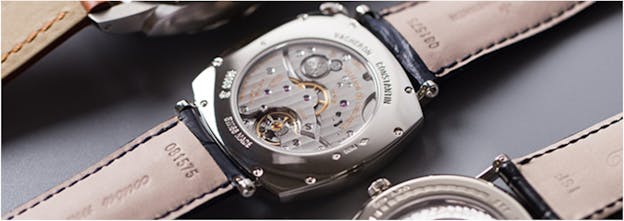Understanding Watch Jewels
In a watch movement, there are many different features such as a balance spring, movement plate and bridges. Jewels are an important part of the movement helping with accuracy and longevity. Jewels used in movements should not be confused with gem-setting on dials, bezels or cases. Watch jewels serve a functional purpose for a timepiece’s movement, while gem-settings are added for aesthetic reasons or to add value. In this article you’ll discover more about:
> History of Jewels in Watches
Using Jewels in Watch Movements
Jewels, or jewel bearings, are synthetic rubies or sapphires that are set into different parts of the watch movement. They are designed to help reduce friction in the moving parts. Their design provides a hard surface that allows the metal components to move freely. Rubies rate a “9” on the Mohs hardness scale, just behind diamonds which measure “10” on the scale.

These stones are placed around pivots, gears and pinions that allow for low friction. Having higher friction within the movement can cause variations in timekeeping and add to premature wear, corrosion and early servicing.
History of Jewels In Watchmaking
Jewels have been in use for almost the entire lifetime of watches, pocket watches, pendant watches and more. In fact, they date back to the early 1700s where Swiss inventor Nicolas Fatio d Duilier and brothers Peter and Jacob Debaufre first developed jewel bearings. The original jewels were made of diamond and corundum, also known as rubies or sapphires. Enthusiasts began to see more accuracy in the timepieces.
The use of natural gemstones added to the cost and exclusivity of timepieces during this period. However, today watchmakers use synthetic sapphires and rubies that help lower the cost.
In the 1930s, the jewels were friction-fit into the main plates and bridges. This meant that the jewels were “rubbed” into the setting, which would in turn be difficult to replace. Modern friction fit jewels are simply pressed into the setting and pressed out of they need repair.
Understanding Jewel Count

Within the movement, there can be a varying number of jewels depending on the brand and model, and the jewel count indicates the number found. A 17-jewel count is considered to be fully jeweled but some brands go up to 21 jewels for added reduction of positional errors. Vintage watches with lower end movements, typically models from before the 1970s, often only feature 5 or 7 jewels. Higher jewel counts typically mirror higher quality, precision and craftsmanship.
The use of a steel or brass bearing within a watch movement would lead to higher friction and then use more power from the mainspring, lowering the power reserve and lifetime of the movement. Jewels can be found in the pivot bearings for wheels, calendar mechanisms, pallet stones, and other automatic and manual winding components. If your watch has an exhibition case back, you can often see a few of the jewels on display. Discover manual-wind watches, automatic watches, or shop all watches with an exhibition case back.


